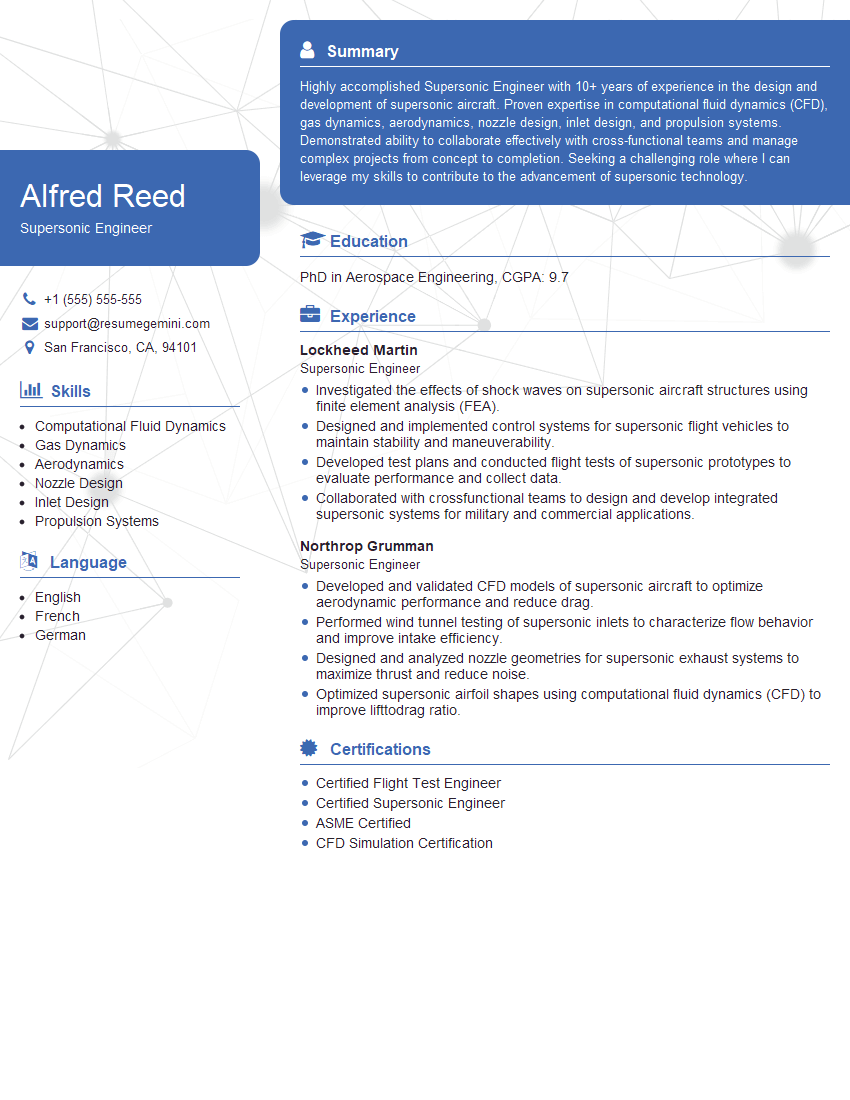Are you a seasoned Supersonic Engineer seeking a new career path? Discover our professionally built Supersonic Engineer Resume Template. This time-saving tool provides a solid foundation for your job search. Simply click “Edit Resume” to customize it with your unique experiences and achievements. Customize fonts and colors to match your personal style and increase your chances of landing your dream job. Explore more Resume Templates for additional options.

Alfred Reed
Supersonic Engineer
Summary
Highly accomplished Supersonic Engineer with 10+ years of experience in the design and development of supersonic aircraft. Proven expertise in computational fluid dynamics (CFD), gas dynamics, aerodynamics, nozzle design, inlet design, and propulsion systems. Demonstrated ability to collaborate effectively with cross-functional teams and manage complex projects from concept to completion. Seeking a challenging role where I can leverage my skills to contribute to the advancement of supersonic technology.
Education
PhD in Aerospace Engineering
May 2016
Skills
- Computational Fluid Dynamics
- Gas Dynamics
- Aerodynamics
- Nozzle Design
- Inlet Design
- Propulsion Systems
Work Experience
Supersonic Engineer
- Investigated the effects of shock waves on supersonic aircraft structures using finite element analysis (FEA).
- Designed and implemented control systems for supersonic flight vehicles to maintain stability and maneuverability.
- Developed test plans and conducted flight tests of supersonic prototypes to evaluate performance and collect data.
- Collaborated with crossfunctional teams to design and develop integrated supersonic systems for military and commercial applications.
Supersonic Engineer
- Developed and validated CFD models of supersonic aircraft to optimize aerodynamic performance and reduce drag.
- Performed wind tunnel testing of supersonic inlets to characterize flow behavior and improve intake efficiency.
- Designed and analyzed nozzle geometries for supersonic exhaust systems to maximize thrust and reduce noise.
- Optimized supersonic airfoil shapes using computational fluid dynamics (CFD) to improve lifttodrag ratio.
Certificates
- Certified Flight Test Engineer
- Certified Supersonic Engineer
- ASME Certified
- CFD Simulation Certification
Languages
- English
- French
- German
Career Expert Tips:
- Select the ideal resume template to showcase your professional experience effectively.
- Master the art of resume writing to highlight your unique qualifications and achievements.
- Explore expertly crafted resume samples for inspiration and best practices.
- Build your best resume for free this new year with ResumeGemini. Enjoy exclusive discounts on ATS optimized resume templates.
How To Write Resume For Supersonic Engineer
- Quantify your accomplishments whenever possible. Use specific numbers to demonstrate the impact of your work.
- Highlight your skills and experience in cutting-edge technologies, such as CFD and FEA.
- Tailor your resume to each job application. Be sure to highlight the skills and experience that are most relevant to the position you are applying for.
- Proofread your resume carefully before submitting it. Make sure there are no errors in grammar or spelling.
Essential Experience Highlights for a Strong Supersonic Engineer Resume
- Developed and validated CFD models of supersonic aircraft to optimize aerodynamic performance and reduce drag.
- Performed wind tunnel testing of supersonic inlets to characterize flow behavior and improve intake efficiency.
- Designed and analyzed nozzle geometries for supersonic exhaust systems to maximize thrust and reduce noise.
- Optimized supersonic airfoil shapes using computational fluid dynamics (CFD) to improve lift-to-drag ratio.
- Investigated the effects of shock waves on supersonic aircraft structures using finite element analysis (FEA).
- Designed and implemented control systems for supersonic flight vehicles to maintain stability and maneuverability.
- Developed test plans and conducted flight tests of supersonic prototypes to evaluate performance and collect data.
Frequently Asked Questions (FAQ’s) For Supersonic Engineer
What is the role of a Supersonic Engineer?
A Supersonic Engineer designs, develops, and tests supersonic aircraft. They use their knowledge of aerodynamics, gas dynamics, and propulsion systems to optimize the performance of supersonic aircraft and ensure their safety and stability.
What are the educational requirements for a Supersonic Engineer?
Most Supersonic Engineers have a Master’s degree or PhD in Aerospace Engineering. They also typically have a strong background in mathematics, physics, and computer science.
What are the skills required for a Supersonic Engineer?
Supersonic Engineers need to have a strong understanding of aerodynamics, gas dynamics, and propulsion systems. They also need to be proficient in computational fluid dynamics (CFD) and finite element analysis (FEA). Additionally, they need to have excellent communication and teamwork skills.
What is the job outlook for Supersonic Engineers?
The job outlook for Supersonic Engineers is expected to be good in the coming years. The demand for supersonic aircraft is increasing, and this is driving demand for qualified Supersonic Engineers.
What are the career opportunities for Supersonic Engineers?
Supersonic Engineers can work in a variety of industries, including aerospace, defense, and research. They can also work for government agencies, such as NASA.
What is the salary range for Supersonic Engineers?
The salary range for Supersonic Engineers varies depending on their experience and education. However, the median salary for Supersonic Engineers is around $100,000 per year.
What are the benefits of working as a Supersonic Engineer?
There are many benefits to working as a Supersonic Engineer. These benefits include the opportunity to work on cutting-edge technology, the opportunity to make a difference in the world, and the opportunity to earn a high salary.